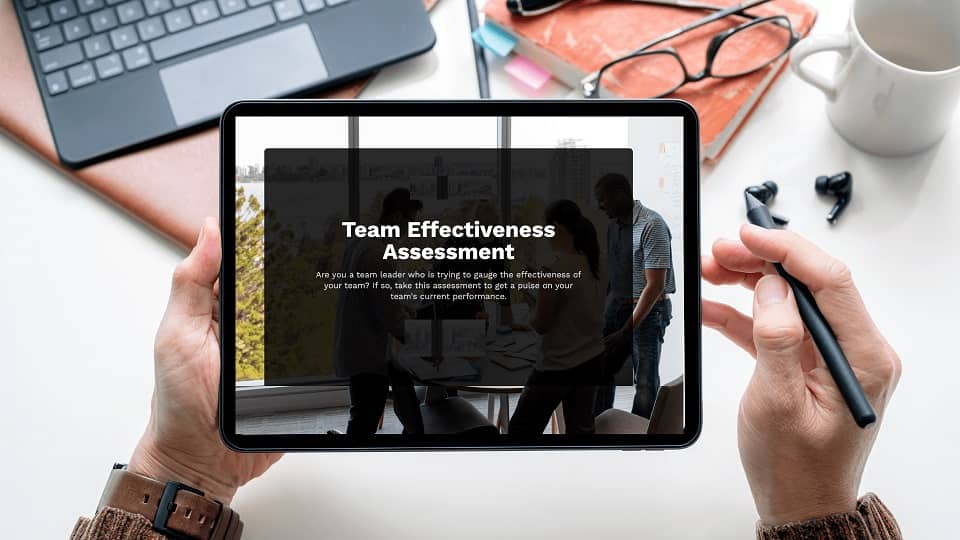Whether you’re looking to understand individual team members, improve communication, or get a clearer picture of how well your leadership skills are working, a structured assessment can help.
While these assessments cannot give you all the answers, they provide valuable insights in assessing team effectiveness. Focus on the ones and twos — if there are any — and start planning your next steps.
Ask Questions
A comprehensive team effectiveness assessment requires a wide variety of questions. Some are objective, such as asking about the team’s performance (for example, how many sales were made). Others are subjective, such as requesting feedback from supervisors or customers.
When deciding what to ask, consider the goals of the assessment. Are you looking to assess the team’s personality, for example? Then choose an assessment tool that focuses on that topic. If you are assessing the team leader, use open-ended questions that encourage the person to talk about themself.
Team effectiveness models generally have a hierarchy with global dimensions at the base and specific dimensions at the top. For example, the rhombus model of team effectiveness emphasizes that effective teams perform as expected (performance), prosper over time (viability), establish credibility with others outside the team (reputation), and support members’ growth and learning. It is important to revise dimensions and measures as the work context changes. Otherwise, fostering one dimension may hinder other dimensions (for example, focusing on productivity at the expense of viability).
Analyze the Results
When the team effectiveness assessment results are available, it is important to review them carefully. Ideally, the assessment will focus on a balanced profile of effectiveness dimensions critical to team members and other stakeholders (client and supervisor). It is also important to recognize that some dimensions may be more relevant for certain teams than others.
For example, in a sales-driven team, measuring the team’s productivity rather than interpersonal relationships is often important. However, in other types of teams, interpersonal relationships may be more important than productivity.
During the evaluation process, it is useful to consider whether you are using an individual or group report. Individual reports provide a snapshot of the team member’s view of the team, while group reports summarize each dimension and provide templates for team development and improvement.
When assessing team effectiveness, it is also worth noting that many models are based on diverse approaches. Some view teams as assets of individuals filling different roles and explain team success as balancing these roles (think Belbin or Z Process strengths). Other models focus on specific teamwork dimensions most relevant to the team’s type, such as performance or viability.
Create a Plan
Team assessments can be conducted in various ways, from in-person sessions to custom-designed online surveys and apps. Some use particular theories about what makes teams work, such as management theorist Meredith Belbin’s suggestion that team members must have a balance of personalities and behaviors to function well (the Belbin roles). In contrast, others focus more on the nature of a team’s processes and the quality of its results.
It’s time to create a plan when the team’s strengths and weaknesses are uncovered. One common method for doing this is through a RACI matrix, which breaks down the responsibilities of each team member into four categories: responsible, accountable, consulted, and informed.
Another popular approach is establishing a “success matrix” that identifies the key metrics of success for the team. This helps clarify the team’s goals and ensures everyone is on board. Another way to build team commitment is by using consensus-based decision-making, which requires that all members commit to a given decision before moving forward. This is a longer process, but it produces better outcomes.
Share the Results
Once you’ve gathered the results, sharing them with the team members is important. This helps everyone see how they’re performing and what areas they need to work on. It also gives team members a chance to highlight their strengths. This can make them feel good about their contributions and motivate them to improve their performance.
It’s important to know that different team effectiveness models highlight global dimensions. For example, some models emphasize team performance, while others stress members’ attitudes and behaviors. These dimensions are in constant interplay, so it’s often necessary to revise the weight of certain dimensions and the sources of information they’re based on over time.
One easy way to conduct an assessment is through a SWOT analysis. Each team member subjectively examines their strengths and weaknesses in this exercise, and a supervisor collates the results. This is a good exercise for new teams, as it can help them get off on the right foot during the forming stage and reduce conflict later in the storming phase.
Implement the Plan
Team members work better together with a shared vision and common goals. Teamwork allows teams to achieve results that exceed the members’ efforts. However, it is important to remember that not all teams are effective. Two major indicators of a team’s effectiveness are profit and employee satisfaction. Satisfied employees will be more likely to remain with the company and more committed to achieving their team’s goals. In addition, a high turnover rate can cost the company in terms of advertising the position, background checks, and time spent interviewing new candidates.
A good way to measure a team’s effectiveness is to use an assessment tool that helps identify areas of concern and provides recommendations for improvement. Some consultants offer team assessments, including the Table Group and the Myers-Briggs.

